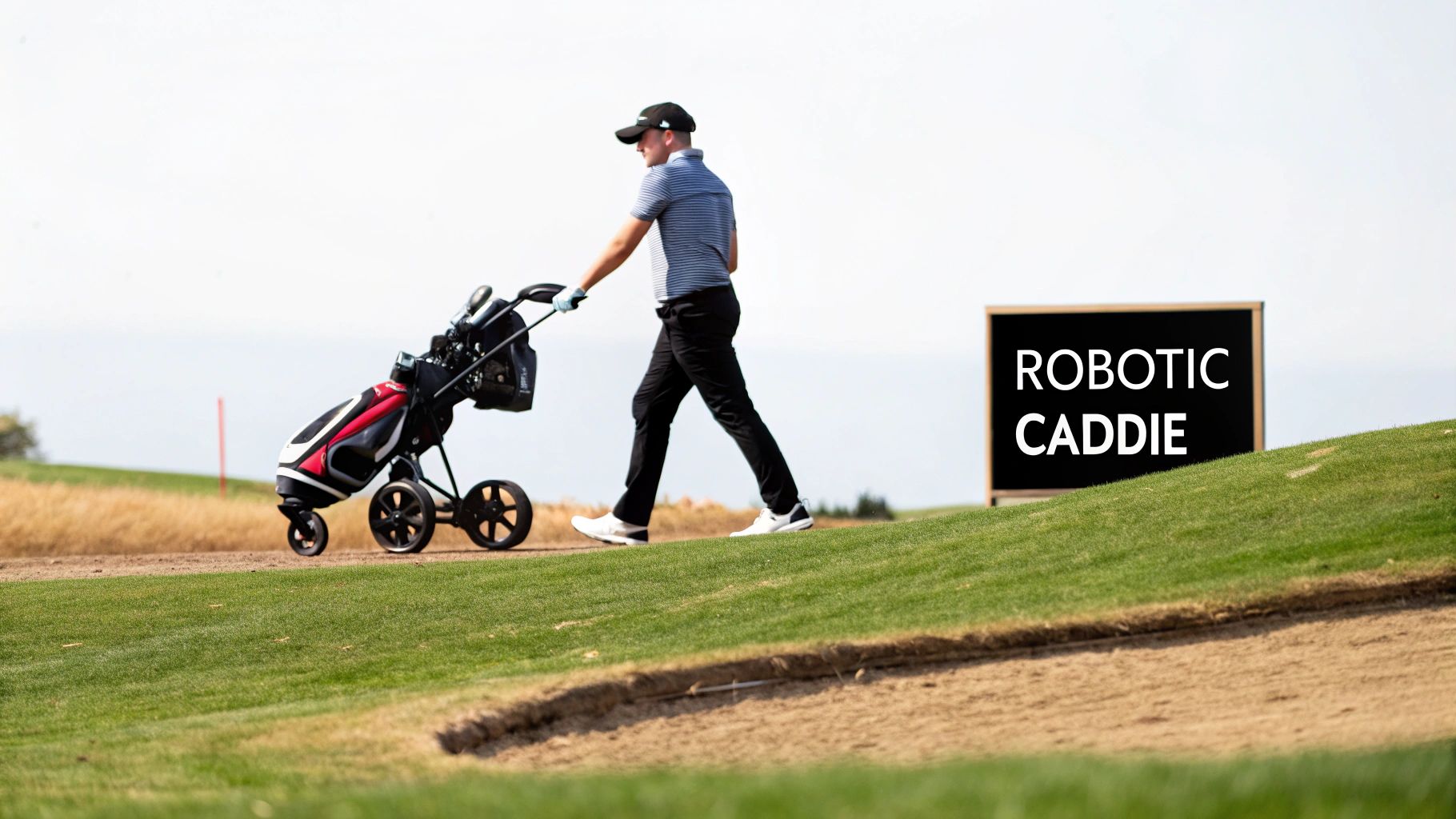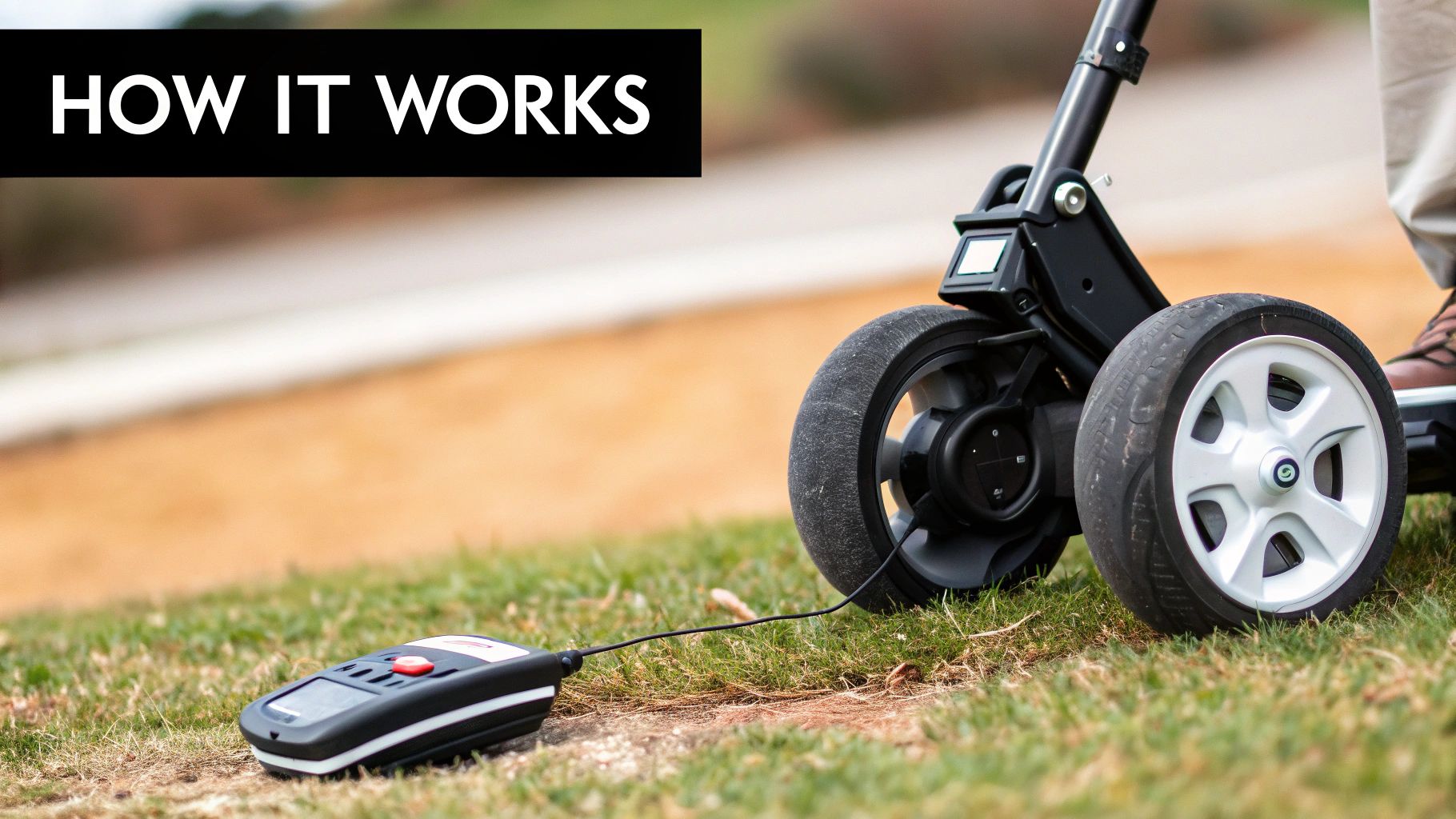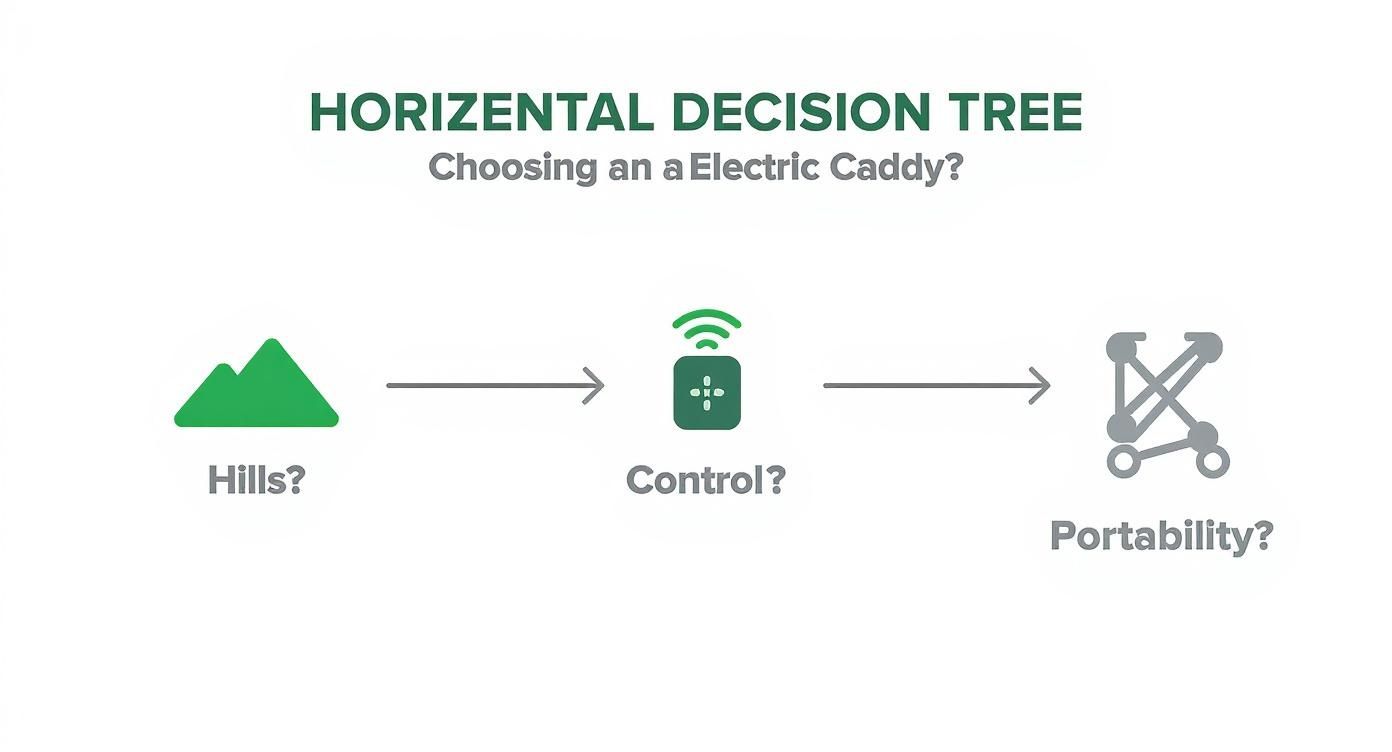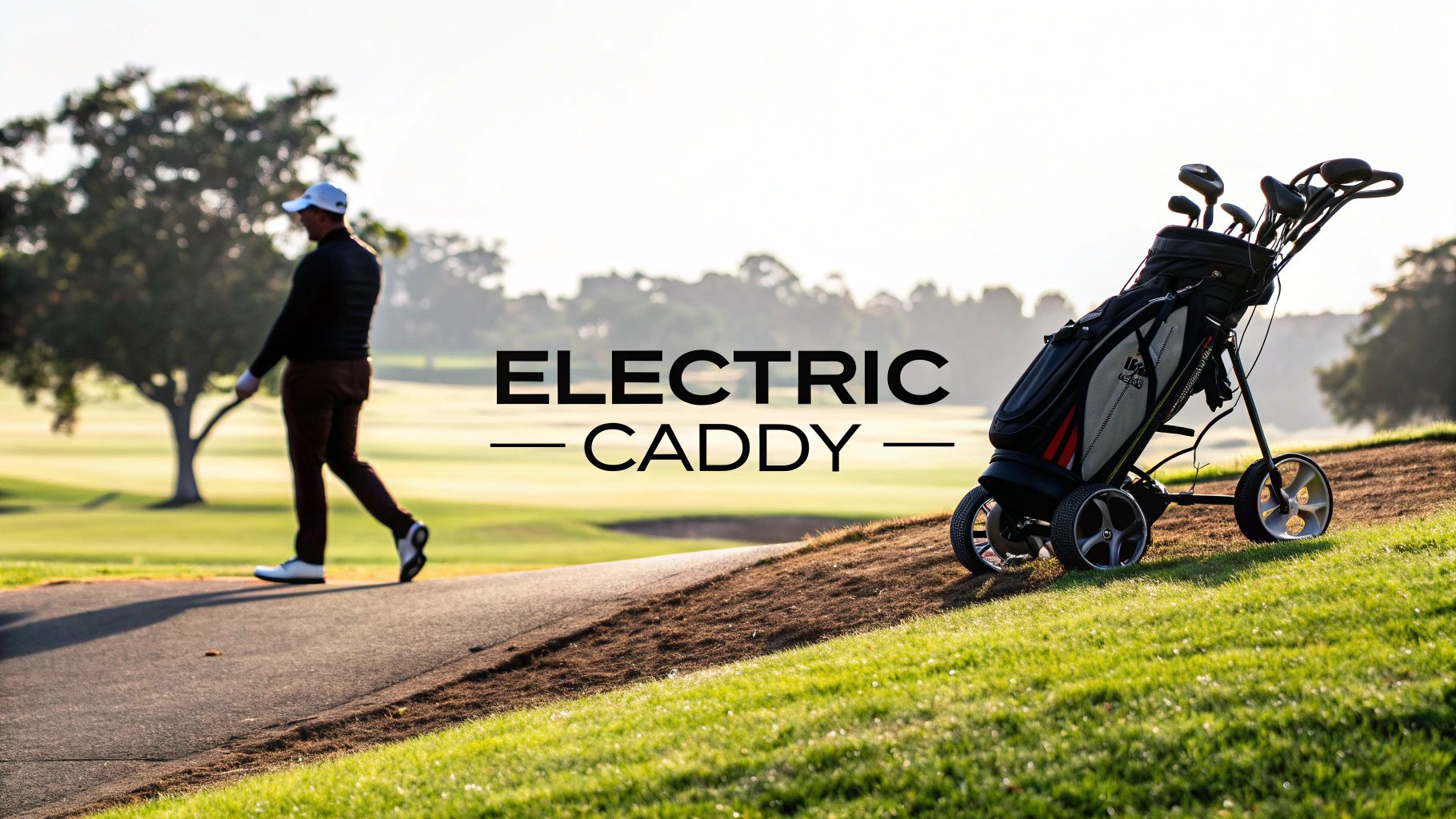Think of an electric golf cart bag as your own personal robotic caddie. It's a smart, motorized system built to carry your clubs so you can walk the course without the physical grind. This technology essentially turns a standard pushcart into a self-driving trolley, saving your energy for what really matters: the game.
What Exactly Is an Electric Golf Cart Bag?

Imagine walking 18 holes, totally dialed in on your next shot, without that nagging fatigue that comes from pushing or lugging a heavy bag. That’s the simple promise of an electric golf cart bag system. It's not a single product, but a whole category of golf tech that breaks down into two main types:
- Integrated Electric Caddies: These are the all-in-one machines. The bag, frame, motor, and wheels are all built together into one seamless unit.
- Power-Assist Wheels: Think of these as conversion kits. They’re designed to clip onto your existing manual pushcart, motorizing it with very little fuss.
It’s a bit like upgrading your commute. A manual pushcart is like a bicycle—it gets the job done, but it demands constant physical effort. An electric caddy, on the other hand, is more like an e-scooter. It handles all the heavy lifting, letting you just guide it along while you save your energy and enjoy the walk.
The Robotic Caddie Analogy
The best way to wrap your head around an electric golf cart bag is to see it as that personal robot caddie. Its job is straightforward but crucial: carry the load so you don’t have to. During a typical 18-hole round, a golfer can burn over 800 calories and walk anywhere from four to eight miles. When you add pushing a 30-pound cart up and down hills to the mix, you're putting significant stress on your body, which can kill your stamina and focus by the back nine.
An electric caddy completely removes that physical burden. You arrive at each shot feeling fresher, more focused, and ready to play your best golf.
This isn’t about being lazy; it's about being smart with your energy. By letting a machine handle the transport, you free up both physical and mental reserves. A potentially grueling walk is transformed into a refreshing, strategic part of your game, leading to a much more enjoyable and less fatiguing round.
Key Benefits of an Electric Caddy at a Glance
So, what's the real-world impact of switching to a powered system? This table breaks down the main advantages you'll see compared to carrying your bag or using a manual pushcart.
| Benefit | Impact on Your Game | Best For |
|---|---|---|
| Reduced Fatigue | Conserves physical energy, preventing late-round slumps and improving focus. | Golfers of all ages, especially on hilly courses. |
| Improved Focus | Allows you to concentrate on shot selection and course strategy, not on pushing a cart. | Players who want to elevate their mental game. |
| Injury Prevention | Reduces strain on your back, shoulders, and knees from carrying or pushing heavy loads. | Seniors or golfers with physical limitations. |
| Enhanced Enjoyment | Makes walking the course more enjoyable and less of a chore, promoting the health benefits of walking. | Anyone looking to get more out of their time on the course. |
Ultimately, using an electric caddy is about preserving your body and mind for the shots that count, making every round a better experience.
How Your Motorized Caddy Navigates the Course
So, what’s the secret sauce that makes these carts glide so effortlessly across the fairway? It’s simpler than you might think.

At its core, every electric golf cart bag runs on a simple but powerful trio: a motor, a battery, and a control system. Think of it like the powertrain in your car, just shrunk down to fit your golf game. The motor is the engine, the battery is the fuel tank, and the controller is the brain telling everything what to do.
When these three parts work in harmony, they transform a heavy bag from a burden into a lightweight companion that just happens to follow you around the course. Your walk becomes about steering, not straining.
The Powerhouse: The Motor and Battery
The motor is what truly separates a powered caddy from your old-school pushcart. You'll generally find two types of motors under the hood, each with its own personality.
- Direct-Drive Motors: These are the strong, silent types. Often found in premium models, they connect right to the axle for whisper-quiet, smooth operation. You’ll barely hear it coming.
- Geared Motors: These are the workhorses. They use a gearbox to muscle up more torque, which is a lifesaver when you're tackling steep hills or tricky terrain. They might be a little louder, but their power is undeniable.
Of course, a motor is nothing without a reliable power source. Thankfully, the days of clunky, heavy lead-acid batteries are long gone. Today, lithium-ion batteries are the gold standard, and for good reason. They're incredibly lightweight, hold a charge for much longer, and can be recharged hundreds of times, meaning they'll last for years.
A modern lithium-ion battery can easily power a caddy for 27 or even 36 holes on a single charge. No more worrying about running out of juice on the back nine.
The Brain: The Control System
This is where the real magic happens. The control system is how you interact with your cart, and it’s what makes the technology feel like you have your own personal caddie. The two most common control methods offer totally different experiences.
Remote Control Operation
The most popular setup involves a small, handheld remote. This gives you total command over the caddy’s speed, direction (forward, reverse, left, and right), and braking. It’s like piloting a little ground drone. You can send your cart ahead to the next tee while you walk over to the green, saving you time and steps.
Follow-Me Technology
Some of the more advanced models feature amazing "follow" technology. You just clip a small sensor to your belt or back pocket, and the cart will follow you like a loyal pup, maintaining a set distance as you walk. This completely hands-free approach is the closest you can get to having a human caddie.
If you're curious about these futuristic options, you can dive deeper in our guide to golf carts that follow you. This tech uses sensors to track your every move, creating a totally intuitive and automated experience.
No matter which control system you choose, the goal is always the same: to give you complete, effortless command over your gear so you can focus on your swing, not on your bag.
Understanding how these systems work helps you see what makes each model special. It's not just a motor slapped on a cart—it’s a sophisticated piece of engineering designed to make your game better.
What Makes a Great Electric Caddy? The Features That Really Matter
When you start looking at electric golf cart bag systems, the feature list can feel a mile long. It's easy to get lost in all the bells and whistles. But here’s the thing: not all of them are created equal.
Think of it like buying a new driver. A flashy headcover is nice, but what you really care about is how it performs off the tee. The same logic applies here. You want to focus on the core features that will actually make your round better, not just add another button to press.
The Non-Negotiables: Battery and Motor Performance
Let's start with the engine room. The heart of any electric caddy is its battery and motor. If these aren't up to snuff, your fancy new gadget will quickly become a very expensive, very frustrating push cart.
First and foremost is the battery life. A solid lithium-ion battery should get you through a full 18 holes without breaking a sweat. Many of the better models on the market have enough juice for 27 or even 36 holes, which is a lifesaver for tournament days or just when you feel like playing a few extra. Always check the battery's capacity, which is usually measured in amp-hours (Ah)—the bigger the number, the longer it'll run.
The motor is just as critical. You need something with enough grunt to handle the hills at your home course without sounding like you've fired up a lawnmower. Look for models that are known for their quiet operation. A loud, whiny motor is a huge distraction for both you and your playing partners.
Control and Navigation Options
How you actually "drive" your caddy is a huge part of the experience, and it really comes down to personal preference. The two main paths you can go down are remote control and "follow" technology.
- Remote Control: This is the most common setup and for good reason—it’s incredibly versatile. A small remote gives you total command over speed, steering, and braking. It’s perfect for sending your cart ahead to the next tee while you walk up to the green, helping to keep the pace of play moving.
- Follow Technology: This is the ultimate hands-free luxury. You wear a small sensor on your belt or keep it in your pocket, and the caddy just… follows you. It maintains a consistent distance, turning when you turn and stopping when you stop. It’s the closest thing to having a real caddie without the weekly paycheck.
The choice really boils down to how you want to interact with your gear. Do you want to be the pilot, or would you rather set it and forget it?
Essential Design and Convenience Features
Okay, beyond the high-tech stuff, there are a few practical features that separate a good caddy from a great one. These are the little details that make a massive difference in day-to-day use.
Wheels and Stability
Your caddy's wheels are its only connection to the course. You want to see wide-tread, anti-tip wheels that create a low center of gravity. This is a huge deal for keeping your cart upright on sidehills and bumpy fairways, preventing your expensive clubs from taking a spill.
Downhill Braking
If your course has even a few gentle slopes, an automatic downhill braking system is an absolute must-have. This feature uses the motor to slow the caddy on descents, so it never gets away from you. It’s a safety feature that gives you total confidence, no matter the terrain.
Portability and Storage
How easily does the thing fold up? A simple, one-piece folding design makes getting it in and out of your car a breeze. Before you buy, do yourself a favor and measure your trunk and where you plan to store it at home. Make sure it’ll fit without a fight.
The market for these accessories is exploding. In fact, the global market for golf cart bags is on track to hit $1,007.8 million in 2025. You can dig into more data about the growing golf cart bag market if you're curious. This trend shows just how much golfers value features that make the game easier and more fun. Oh, and don't overlook small perks like a built-in USB port—being able to charge your phone or GPS during a round can be a real lifesaver.
Choosing Between a Conversion Kit and an Integrated Caddy
When you decide to add power to your walk on the course, one of the first big questions you'll face is whether to buy a brand-new, all-in-one unit or to upgrade the gear you already have. This decision really comes down to two paths: getting a fully integrated electric caddy or motorizing your trusty push cart with a conversion kit. Each option has its own set of perks, depending on your budget, how much storage space you have, and your personal style of play.
Think of an integrated caddy like buying a new car straight from the dealership—it’s a single, purpose-built machine where every part is designed to work together flawlessly right out of the box. A conversion kit, on the other hand, is like dropping a powerful new engine into your favorite classic car. It gives a new lease on life to something you already own and love, offering a more affordable way to get that motorized boost.
Power-Assist Wheels vs Integrated Electric Caddies
To make this choice a little clearer, let’s put these two options side-by-side. An integrated caddy delivers a seamless, feature-heavy experience but usually comes with a higher price tag and takes up more room in your garage or car trunk. A conversion kit, however, is all about flexibility and value, letting you stick with the push cart you're already comfortable with.
The table below breaks down the key differences to help you figure out which path is the right one for you.
| Feature | Power-Assist Wheels (Conversion Kit) | Integrated Electric Caddy (All-in-One) |
|---|---|---|
| Cost | More affordable initial investment. | Higher upfront cost. |
| Compatibility | Works with your existing push cart. | A complete, self-contained unit. |
| Storage & Portability | Easy to detach; highly portable and compact. | Larger and heavier; requires more storage space. |
| Features | Typically includes core functions like speed control. | Often comes with advanced features (GPS, downhill braking). |
| Setup | Quick and simple attachment/detachment. | No setup required, but bulkier to transport. |
| Best For | Golfers who love their current cart and want a flexible, budget-friendly upgrade. | Golfers who want a premium, feature-rich experience and don't mind the investment. |
Ultimately, this comparison shows that your decision hinges on what you value most: the convenience and advanced tech of an all-in-one system, or the affordability and adaptability of upgrading your current setup.
The infographic below offers a simple decision tree to help guide your choice based on your typical course conditions and what features matter most to you.

This visual guide helps simplify things, showing that your decision often boils down to factors like the terrain you play on, how much control you want, and your need for portability.
Which Option Is Right for You?
The best choice really depends on your specific situation. For instance, a golfer who travels a lot or has limited storage space at home would find a compact power-assist kit to be a perfect fit. It’s easy to pop off and store, and you can bring that motorized help to any course without needing a big vehicle to haul it. Our guide to a golf push cart electric conversion kit dives deeper into these flexible systems.
On the other hand, a dedicated club member who plays the same hilly course every weekend would probably get more out of a robust, integrated caddy. These units are built for stability and often pack in advanced features like downhill braking, giving you total confidence on tricky terrain.
By thinking through these real-world scenarios, you can confidently pick the option that best suits your game.
Your First-Time Setup and Pre-Round Checklist
Getting started with a new piece of golf tech should be exciting, not a chore. The good news is, setting up your electric golf cart bag system for the first time is a quick and simple process that gets you ready for the fairway in just a few minutes.
The most important thing to do right out of the box is condition the battery. Think of it like a new smartphone—you want to give it a full, uninterrupted charge before its first adventure. This simple step helps calibrate the battery cells, maximizing its long-term health and ensuring you squeeze every last yard out of each charge. If you want to dive deeper into the science, our guide on how to test battery capacity has you covered.
With the battery juiced up and ready, the next step is pairing your remote control. This is usually as easy as pressing a button on both the remote and the main unit. Your user manual will have the exact instructions, but it typically takes just a few seconds.
Initial Assembly and Alignment
If you're using a power-assist conversion kit, the final setup step is attaching the motorized wheel unit to your pushcart. The goal here is to get everything perfectly aligned so your cart tracks straight and true, without pulling to one side.
Start by securely fastening the mounting bracket to your cart's axle or frame. Make sure it's centered and tightened down properly. Then, click the motorized wheel unit into place. Give it a gentle push forward to confirm it rolls smoothly and doesn’t veer left or right.
Taking an extra five minutes for a proper initial setup not only guarantees a smooth first round but also prevents unnecessary wear and tear on your gear down the road. A little patience now saves a lot of headaches later.
Your Pre-Round Checklist
Before you head out for a round, running through this quick checklist will ensure a hassle-free day on the course. Make it a habit!
- Battery Check: Is the battery fully charged? That little green indicator light is your best friend.
- Remote Sync: Power on the remote and main unit to make sure they connect. Give the forward and reverse buttons a quick test.
- Wheel Inspection: Glance at the wheels to make sure they're free of mud or grass and are securely attached.
- Secure Your Bag: Give the straps a final tug to confirm your golf bag is snug and won't shift around on hills or uneven ground.
Still Have a Few Questions?
Thinking about adding an electric caddy to your golf game is exciting, but it's natural to have a few practical questions pop up. Let's tackle some of the most common ones to clear up any lingering doubts.
How Long Does The Battery Last On A Single Charge?
Most modern electric caddies are powered by lithium-ion batteries that are more than capable of lasting a full 18 holes. If you opt for a premium model, you can often find extended-life batteries that will comfortably get you through 27 or even 36 holes without a problem.
Of course, real-world performance depends on a few things. Hilly terrain, a heavier golf bag, and even the age of the battery can affect how long it runs. A good rule of thumb? Always give it a full charge before you head out to the course.
Are They A Pain To Use On Hilly Courses?
Not at all—in fact, this is where they really shine. The best electric caddies are built with powerful motors and, more importantly, features like automatic downhill braking. This clever bit of tech stops the caddy from getting away from you on steep slopes, which is a total game-changer.
It's what makes walking a hilly course so much less draining than wrestling with a manual pushcart. You get stability and control right when you need it, turning a tough walk into a total breeze.
For extra peace of mind on uneven ground, look for models with a wide wheelbase.
Can I Use My Existing Golf Bag?
In most cases, yes. The majority of integrated electric trolleys come with adjustable bag holders designed to fit both stand and cart bags. That said, a cart bag will almost always give you a more snug and secure fit.
And if you're looking at a power-assist wheel kit, you're in even better shape. Those systems are specifically designed to attach right onto your current manual pushcart, so you can keep using the bag you already know and love.
How Much Maintenance Do They Actually Need?
You'll be pleasantly surprised—electric caddies are incredibly low-maintenance. Your main jobs are just keeping the battery charged and giving the frame and wheels a quick wipe-down after a muddy round to keep everything clean. Storing it somewhere dry is also a good idea.
Really, the most important thing is to follow the manufacturer's instructions for battery care. Do that, and your caddy will be a reliable partner on the course for years to come.
Ready to transform your walk on the course? Explore the simple, powerful design of the Caddie Wheel and enjoy the game with less effort and more focus. Learn more and get yours at https://caddiewheel.com.


Share:
What Is a Push Cart and Why It Improves Your Golf Game
golf clubs carrier: Top Choices for Carts, Bags & Electric